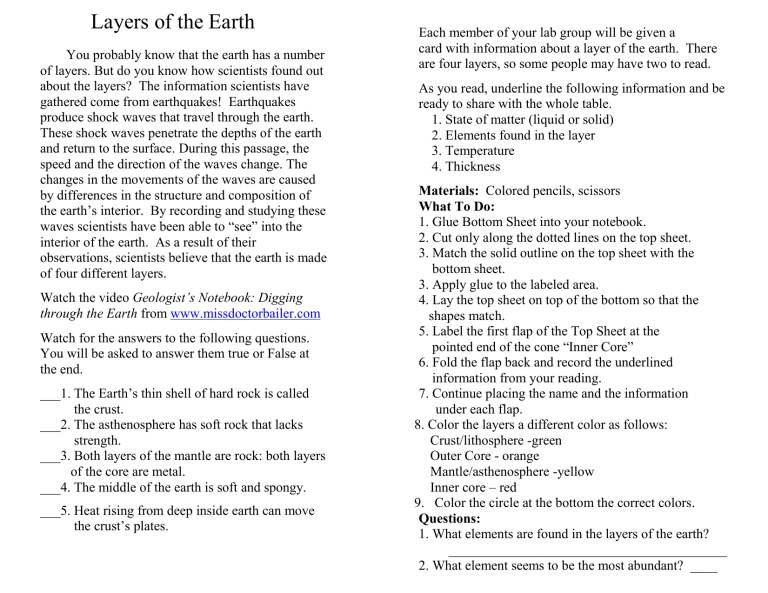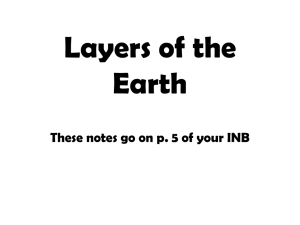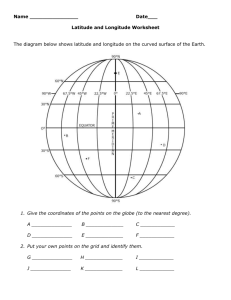Layers of the Earth Worksheet: Science Activity
advertisement

Layers of the Earth You probably know that the earth has a number of layers. But do you know how scientists found out about the layers? The information scientists have gathered come from earthquakes! Earthquakes produce shock waves that travel through the earth. These shock waves penetrate the depths of the earth and return to the surface. During this passage, the speed and the direction of the waves change. The changes in the movements of the waves are caused by differences in the structure and composition of the earth’s interior. By recording and studying these waves scientists have been able to “see” into the interior of the earth. As a result of their observations, scientists believe that the earth is made of four different layers. Watch the video Geologist’s Notebook: Digging through the Earth from www.missdoctorbailer.com Watch for the answers to the following questions. You will be asked to answer them true or False at the end. ___1. The Earth’s thin shell of hard rock is called the crust. ___2. The asthenosphere has soft rock that lacks strength. ___3. Both layers of the mantle are rock: both layers of the core are metal. ___4. The middle of the earth is soft and spongy. ___5. Heat rising from deep inside earth can move the crust’s plates. Each member of your lab group will be given a card with information about a layer of the earth. There are four layers, so some people may have two to read. As you read, underline the following information and be ready to share with the whole table. 1. State of matter (liquid or solid) 2. Elements found in the layer 3. Temperature 4. Thickness Materials: Colored pencils, scissors What To Do: 1. Glue Bottom Sheet into your notebook. 2. Cut only along the dotted lines on the top sheet. 3. Match the solid outline on the top sheet with the bottom sheet. 3. Apply glue to the labeled area. 4. Lay the top sheet on top of the bottom so that the shapes match. 5. Label the first flap of the Top Sheet at the pointed end of the cone “Inner Core” 6. Fold the flap back and record the underlined information from your reading. 7. Continue placing the name and the information under each flap. 8. Color the layers a different color as follows: Crust/lithosphere -green Outer Core - orange Mantle/asthenosphere -yellow Inner core – red 9. Color the circle at the bottom the correct colors. Questions: 1. What elements are found in the layers of the earth? _________________________________________ 2. What element seems to be the most abundant? ____ Top Sheet Bottom Sheet Name ____________________ period _____ Name ____________________ EXIT TICKET EXIT TICKET Layers of the Earth Layers of the Earth 1. What is the name of the layer at the center of the earth? a. outer core b. inner core c. mantle d. crust 2. What is the name of the layer at the top of the earth? a. outer core b. inner core c. mantle d. crust 3. What is the core made of? a. rock b. sponge c. metal d. dust 4. The core’s temperature is a. very hot b. medium hot c. warm d. cool 5. The crust and the upper layer of the mantle combine to make the a. outer core b. asthenosphere c. mantle d. lithosphere period _____ 1. The core’s temperature is a. very hot b. medium hot c. warm d. cool 2. The crust and the upper layer of the mantle combine to make the a. outer core b. asthenosphere c. mantle d. lithosphere 3. What is the name of the layer at the center of the earth? a. outer core b. inner core c. mantle d. crust 4. What is the name of the layer at the top of the earth? a. outer core b. inner core c. mantle d. crust 5. What is the core made of? a. rock b. sponge c. metal d. dust Layers of the Earth Cards The Inner Core The deepest layer in Earth is the inner core. It is located at the center of Earth because it is the densest material of all Earth’s layers. The inner core is solid and mostly composed of the element iron (Fe). It’s extremely hot temperature is estimated at 6000°C. This layer is approximately 1,250 km thick. Print 1 sheet for each table The Mantle and the Asthenosphere The mantle is located outside the outer core. This layer is mostly made of iron (Fe) and magnesium (Mg) and has a thickness of approximately 2,900 km. The upper mantle has two layers and it’s high temperatures of 2,800-3,200°C can melt rocks. The deepest layer in the upper part of the mantle is called the asthenosphere and it is semisolid. Semisolid is a solid that flows like a liquid. The Outer Core The outer core is less dense than the inner core and, therefore, is located around the inner core. The temperatures range from 4,000°C to 5000°C. The outer core is approximately 2, 200 km thick and is a combination of mostly molten iron (Fe) and nickel (Ni). Molten describes materials that change to liquid form when exposed to extreme amounts of thermal energy. The Crust and Lithosphere The layer around the asthenosphere is known as the lithosphere. The lithosphere is the solid outer layer of the Earth that consists of the crust and the second layer of the upper mantle. This layer is made mostly of the elements oxygen (O2) and silicon (Si). The crust is the thinnest layer of Earth and has a temperature range from 200°C 400°C. Continental crust is thicker than oceanic crust, which is 5-8 km thick.







